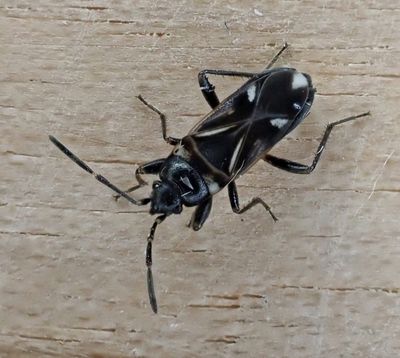Cool Critters: Well-dressed tuxedo bug longs to exit your house

Wouldn’t it be great if the visitor sporting a finely fitted tuxedo in your living room was James Bond? No such luck – it’s an insect dressed in nature’s formalwear.
Meet the tuxedo bug, a critter with a black body and white trim that is active in homes this time of year.
Scientifically known as Raglius alboacuminatus, it came indoors last fall, probably through a tiny crack or gap near a door, window or vent. After spending the winter quietly loitering in some nook or cranny, the insect was coaxed into the open by warmer temperatures and added daylight.
And now, the six-legged interloper is looking for a way back outside. If all goes well, the bug will return to nature and find a little romance, a good meal and a bit to drink. Shaken, not stirred.
Common in Europe, North Africa and parts of Asia, the tuxedo bug is relatively new to the United States. A population was first discovered in Utah in 1999, according to a University of Idaho Extension report, followed by California and Oregon in 2002, Idaho in 2004, and Washington in 2005.
Sure, the tuxedo bug lacks the suaveness of 007, but having one or several inside your home typically isn’t a problem, entomologist Richard Zack of Washington State University said. Unlike other insects such as termites, cockroaches, fleas and pantry pests, “they don’t cause damage to the home and they don’t bite, sting or feed on our food,” he said. What’s more, they don’t reproduce indoors.
This slender, quarter-inch-long insect has been described as “handsome” and “attractive” in scientific literature because of its tuxedo-like appearance. Handsome or not, you wouldn’t want large numbers congregating under your roof.
Instead of one or two tuxedo bugs scuttling along the floorboards or a sunlit windowsill, there might be dozens.
“Although they don’t do anything ‘bad,’ this is an infestation problem for homeowners,” Zack said.
Fortunately, infestations aren’t common and occur mostly in buildings located near weedy fields and pastures, he said.
What to do if you encounter a tuxedo bug in your home? Now that the weather is warmer, you can simply toss it outside. The insects aren’t known to eat garden plants, crops or trees, according to the UI extension report authored by entomologists Edward Bechinski and Frank Merickel.
“Raglius is a seed-feeding insect that only seems to feed on certain weedy plants,” they write.
What to do if the insects occupy your home en masse? Zack suggests you get out the vacuum cleaner and suck them up.
And one more thing. The UI report advises homeowners not to step on tuxedo bugs. “When crushed, their bodies do emit a slightly offensive scent.”
A scent, of course, that smells nothing like James Bond’s aftershave.